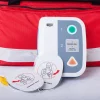
Recent Post
- What Maintenance Is Required for an AED: Everything You Need To Know
November 14, 2025  Could You Recognise the Signs That Someone Needs a Defibrillator?
Could You Recognise the Signs That Someone Needs a Defibrillator?
September 12, 2023
Introduction to Pulse Oximeters
As we kick off this exploration, let’s set the scene, shall we? What’s a pulse oximeter, and why should we care?
What is a Pulse Oximeter?
A pulse oximeter is a small device that measures the amount of oxygen in your blood. It’s non-invasive, which means no needles – hurrah! It attaches painlessly to your fingertip to give you the readings you need.
How Does a Pulse Oximeter Work?
Science magic, you might say, but let’s get a bit more technical. The device shines a light through your finger, measuring the amount of oxygen in your blood based on how much light is absorbed. Neat, right?
The Role of Portable Pulse Oximeters for Travelers
So, you’re probably asking, “Why should a traveller care about this gadget?”
Vital Role in Health Monitoring
When we’re on the move, keeping an eye on our health becomes even more critical. A portable finger pulse oximeter can help us do just that by providing on-the-spot readings of our blood oxygen levels. This is especially handy for travellers with health conditions that need close monitoring.
Convenience Factor
Convenience is the name of the game for any savvy traveller. The compact size of portable pulse oximeters means you can easily slip one into your pocket or carry-on luggage.
Benefits of Portable Pulse Oximeters
With the basics covered, let’s get down to the real question – why should you pack a portable pulse oximeter on your next trip?
Portability
Imagine this: You’re halfway up a mountain trek, breathing is getting tough, and you want to check your oxygen levels. With a portable pulse oximeter, you can do just that. These small devices are light and compact, making them ideal for travellers.
Easy to Use
No one wants to fiddle around with a complicated device when they’re out exploring. Luckily, portable pulse oximeters are simple to operate. Just clip it on your finger, press a button, and voila! You’ve got your reading.
Quick and Accurate Results
The beauty of these devices is that they give quick and accurate results. Within seconds, you’ll know whether your oxygen levels are within a healthy range.
Comparing Portable Pulse Oximeters with Traditional Oximeters
Traditional oximeters are usually larger and more suited to clinical settings. They offer high precision but can be overkill for a casual traveller. The portable models offer a balance between convenience and accuracy, making them a great choice for on-the-go health monitoring.
Importance of Brand: Priority First Aid
Quality Assurance
As with any device, not all pulse oximeters are created equal. Choosing a reputable brand like Priority First Aid ensures you’re getting a device that meets all the necessary safety and accuracy standards.
Customer Service
Priority First Aid prides itself on its top-notch customer service. With their product, you can travel with peace of mind, knowing help is just a phone call away.
How to Choose the Right Pulse Oximeter for Your Travel Needs
Choosing the right oximeter depends on various factors like your health needs, budget, and the kind of travelling you do. Make sure to consider the device’s accuracy, battery life, size, weight, and cost before making a decision.
Conclusion
To wrap up, portable pulse oximeters are a boon for travellers. They’re compact, easy to use, and can be a literal lifesaver in certain situations. Consider adding one from a reliable brand like Priority First Aid to your travel kit today!
FAQs
1. Can I use a pulse oximeter at high altitudes?
Yes, portable pulse oximeters are particularly useful at high altitudes where oxygen levels can decrease.
2. How accurate are portable pulse oximeters?
Most portable pulse oximeters have an accuracy of +/- 2%.
3. How often should I use a pulse oximeter while travelling?
This depends on your health conditions. If you have a respiratory condition or are travelling to high-altitude areas, you might need to check more frequently.
4. How do I know if my pulse oximeter is working correctly?
Most pulse oximeters have self-check functions. If you’re unsure, consult the device manual or reach out to the manufacturer’s customer service.
5. What should I do if my oxygen level reading is low?
If your reading is consistently below 95%, seek medical advice immediately.




